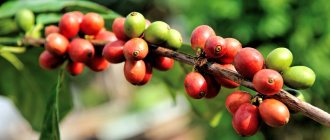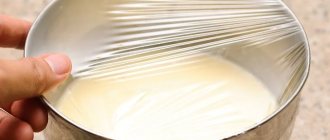Coffee producers are Germany, France and Italy. But in fact they are not. There are no coffee trees in Europe. In these countries, grain raw materials are fried, ground and packaged in jars, boxes, and bags. Countries where coffee grows include America, Africa, Asia, and Australia. From there, processed and dried green grains are transported to European factories.
What delicious coffee in Melbourne, Australia
Coffee is an integral part of the Melbourne lifestyle. Every year there is an exhibition of coffee - varieties, producers, everything for preparing the drink.
This is a kind of club of interests. It consists not only of major players in the coffee market, but also of ordinary consumers who are crazy about this drink.
In addition, tourists are offered coffee tours to the best establishments in the city where this aromatic nectar is brewed.
What to order: Piccolo Latte
Milk is poured into the cup; it should make up about 2/3 of the serving. Then slowly pour in the espresso and add sugar to taste.
Leaders in coffee growing
Brazil
A state on the South American continent with an equatorial or subequatorial humid climate that is suitable for growing coffee. The average annual temperature is within 18-28°C. Precipitation amount is 1500-3000 mm per year. This allows you to maintain gardens and achieve record harvests.
Brazil produces a third of the total world volume - up to 40 million bales per year. Arabica, Robusta, Serrato, Bourbon, Bahia and Santos are grown here. Brazilian grains are of low quality - farmers are chasing quantity.
There are 800 million coffee trees in the country. In 365 days, one yields up to 3.5 kg of grains.
Main importers: USA, Italy, Japan, CIS countries led by Russia. According to experts, the state exports only 30% of the harvest. The rest goes to the domestic market. On average, each Brazilian consumes 5 kg of grains per year.
Information on the topic is in the article “Which countries occupy the first places in coffee consumption.”
Colombia
In the south of Colombia, in the Andes, high-quality Arabica beans are grown. Robusta is not found here. Manufacturers focus on quality. Colombia's market share is impressive - up to 9%, which is equal to 10 million bales. Such indicators allow the state to be one of the three largest global producers.
Interesting! Can mothers drink coffee while breastfeeding?
Varieties: Colombia Supremo, Supremo Medellin, Excelso, Bogota. The main exports are to the USA, Germany, France, Italy and Japan.
Indonesia
A state located on the islands of the Malay Archipelago in the Pacific Ocean. Specializes in growing high quality Arabica beans.
Coffee production here was started by Europeans back in the 17th century, and the Java, Sumatra, and Sulawesi varieties are still considered elite. Indonesia produces robusta - up to 9 million bales per year.
Vietnam
Coffee trees were brought to Vietnam in the second half of the 19th century and the industry did not develop until the 1980s.
At the end of the last century, Vietnam began to increase production at an accelerated pace. It has become a world leader and is currently second only to Brazil in terms of volume.
However, Vietnam is the only one that specializes in growing exclusively robusta. The Vietnamese market share is 18% of the total global volume.
Mexico
In the south of Mexico, more than 100,000 farmers cultivate Arabica varieties: Altura, Pluma, Liquidambar MS. Mexican exporters supply up to 6 million bales per year to the foreign market.
Ethiopia
The list of leaders in coffee production on the African continent is headed by Ethiopia, the birthplace of the coffee tree. Here it is possible to grow up to 4 million bales of dry grains in a good year, which is equal to 5% of the world market share.
The Sidamo variety, which is grown in the vicinity of the city of Kaffa, is rightfully considered one of the best in the world. In addition, Arabica varieties Harar and Yirgachif are produced. A quarter of the population is engaged in plantation cultivation.
India
India produces up to 3.8 million bales of premium Arabica coffee. There is an “Indian Coffee Council” in the country, which monitors the quality of the beans collected.
The technology of dry drying of raw materials gives the Indian product a delicious, unique taste. Famous varieties are Monsoon Malabar and Mysore.
Guatemala
Another American state included in the top 10 largest producers. Guatemala produces grains of the elite Huetenango and Atitlan varieties. Harvests reach 3.5 million bales per year.
Ivory Coast
At the end of the 90s, this African state received 0.9 million bales more than now. The sharp decline is associated with low-quality raw materials. To grow a lot of expensive product, planters switched to robusta. About 3.3 million bales enter the world market from Côte d'Ivoire.
Interesting! Which countries rank first in coffee consumption?
Uganda
Uganda closes the list of countries supplying grains to the world market. This small country in Africa offers robusta, although Arabica also grows there.
This is the only economic sector and almost the entire working population is employed on plantations. The average annual harvest reaches 3 million bales.
Espresso - delicious coffee in Rome, Italy
Roman cafes desperately resist technological progress. They prefer to brew coffee the old fashioned way without newfangled devices. Perhaps this is why Italy has the largest number of winners of coffee competitions and competitions.
Baristas create real masterpieces. They say that the art of making pictures in coffee cups originated in Rome.
Sitting on the square by the fountain of the eternal city, sipping strong coffee at a small table, is a special pleasure.
What to order: Espresso
It is customary to drink coffee with milk here only for breakfast.
TOP 5 best coffee shops in Rome
To visit Rome and not try real Italian coffee means to learn nothing about Italy. Italians spend quite a lot of time in coffee shops, which are called bars here. The best coffee in Rome can be had in places like these.
Antico Caffè Greco (Via dei Condotti, 86)
An excellent choice for those who want to touch Italian history. Just think, famous poets, philosophers, and composers gathered in this cafe for intellectual conversations! Hans Christian Andersen, Mark Twain, and Wilhelm Richard Wagner visited him when they were in Rome.
The atmosphere of Antico Caffè Greco is a world of Old World luxury with gilded decorations, marble tables, works of art on the walls. Prices here are quite high. A cup of espresso drunk at a table in this cafe will cost 7 €. Not cheap, but the pleasure is worth it.
Sant Eustachio Il Caffe (Piazza di San Eustachio, 82)
The cafe is located in the very center of Rome, not far from the Pantheon. Coffee is brewed here according to a special recipe, which is kept in the strictest confidence. Regular espresso at Sant Eustachio Il Caffe has a completely unimaginable aroma, a special thick foam and a dark chocolate aftertaste. Be sure to also try Caffè d'Elite – 3.9 € and the signature Gran Caffè – 5.4 €.
The cafe has a store where you can buy beans or ground coffee to treat yourself to the unique taste of the drink at home. A 250 g can of one of the branded coffee beans costs 7.9 €, in soft packaging – 6.3 €.
D'Angelo – Gastronomia Caffe (Venti Settembre, 25)
Best place in Rome for an inexpensive Italian breakfast. Amazingly delicious fresh pastries and cappuccino costing only 1.2 € will not leave anyone indifferent. A typical Italian atmosphere and a smiling bartender will help you feel the real spirit of Italy.
Tazza D'Oro (Via Marche, 52)
Tazza D'Oro is the name of a coffee shop in Italy, which is associated with a black beauty who sows coffee beans around the world. This is the logo that greets visitors at the entrance to the cafe. There is an exceptionally delicious latte - 1.1 €, cappuccino - 2.2 € and espresso for 0.9 €.
You can also buy branded coffee with the cafe’s logo to take with you: a 250 g package costs 10.87 €, 1 kg – 43.45 €, a 250 g can – 13.17 €.
Sciascia Caffe (Via Fabio Massimo, 80/A)
This place is recommended by locals. There are few tourists here, a quiet, calm environment. The delicate smell of freshly baked croissants and the invigorating aroma of coffee makes you feel dizzy already on the threshold of the cafe. You will be served a cappuccino, masterfully decorated with a design of foam, at a price of 1.3 € per cup. I want to come back here again and again!
Italy and coffee are inseparable concepts; people here truly know how to infect people with their love for this drink. And once you try real Italian coffee, you will certainly become a fan.
Tell your friends: Facebook
VK
Do not miss:
7 of the most delicious restaurants in Florence
Italian ice cream - the shortest route to Dolce Vita
Bruschetta is not just an Italian sandwich
Where to try the best gelato in Rome
>>> Car rental in Italy. All SECRETS, features and Lifehacks <<
THE WHOLE TRUTH ABOUT ONLINE TOURS!!!
02.11.2019
Tell your friends: Facebook
VK
More on the topic
10 magical Italian desserts
Where to eat Florentine steak in Florence
Where to buy fresh food in Rome
Viennese delicious coffee
In 2011, UNESCO listed Vienna's coffee shops as an intangible heritage of humanity. It is customary to spend time in them thoroughly - several hours, or even the whole day.
This is a meeting place for friends, where they watch TV, read newspapers and discuss the latest news over a cup of aromatic coffee, served with apple strudel. Austria even has its own signature coffee options that you won’t try anywhere else.
What to order:
- Capuchiner (Black coffee with milk the color of the Capuchin monk's robe),
- Chalet Gold (coffee with a fair amount of milk, thanks to which the drink acquires a noble golden color),
- Maria Theresa (Mocha with orange liqueur)
Export of coffee beans
The cleaned, sorted and polished beans, now called green coffee, are loaded onto ships in jute or sisal bags loaded into shipping containers, or transported in bulk in plastic-lined containers. According to the USDA, global coffee production is projected to be 169.33 million 60kg bags in 2019/20.
coffee beans
Is there good coffee in London, UK?
England, and London in particular, is associated with tea. Her Majesty's subjects tried coffee in the mid-1990s. At this time there was a boom in the opening of coffee shops, most of them concentrated in the East End, and they were opened by immigrants from Australia and New Zealand - famous coffee gourmets.
What to order:
- Flat white (The basis of this drink is espresso, which is prepared for 15, not 30 seconds, as usual. Steamed milk is added to it),
- cappuccino.
Coffee belt
Optimal conditions
The homeland of coffee trees is Ethiopia and the territory of modern Yemen, which is located on the Arabian Peninsula. Here these plants grew wild.
The following climatic conditions are necessary for tree growth and fruit ripening:
- average annual air temperature – 20°С;
- precipitation amount – 1000-1800mm per year;
- Some trees require high altitudes.
Interesting! Is it possible to drink expired coffee?
These conditions correspond to a tropical climate. In other climatic zones, coffee trees are found as ornamental non-fruit-bearing plants. Whether coffee grows on mountain slopes or in valleys determines its taste and smell.
Belt coverage area
Regions that have suitable climatic conditions for growing coffee trees are located along the equator. They move away from it at 20° north and south latitude. The corridor, which is limited by these latitudes, encircles the planet. Hence the name coffee belt of the earth.
According to the world map, the belt covers the territories of South and Central America, Central Africa, Southeast Asia, Australia, New Zealand and the islands of Oceania. In total, there are 80 countries where coffee is grown. But only 50 of them are world exporters.
The turnover of coffee raw materials is 5 million tons per year. There are leaders in this market - coffee producing countries. The harvest is measured in bales, each containing 60 kg of green grains.
Let's look at which countries coffee is grown in.
Icelandic delicious coffee in Reykjavik
All 7 coffee shops in the Icelandic capital are thriving. They are full of guests, and the baristas are constantly preparing all kinds of coffee. The descendants of the Vikings never limited themselves to one cup.
When the weather warms up on the North Island, outdoor tables pop up outside coffee shop windows. Residents of Reykjavik soak up the sun while sipping their favorite drink. They can spend the whole day like this.
What to order: Latte or cappuccino
Where is coffee grown?
Where is coffee grown?
Many people, brewing a cup of invigorating drink every morning, are unaware of where the coffee is grown.
The coffee tree cannot be grown everywhere, at least in large quantities. This limitation is mainly due to climatic factors. The coffee tree is a rather whimsical plant. Coffee loves hot climates and bears fruit well in countries where the average annual temperature is from 18 to 22 °C. In addition to heat, coffee requires height. For Arabica, the most favorable conditions are the tropical zone, located above sea level at 600-1200 m. Robusta can grow at an altitude of up to 600 m. Sudden changes in temperature and low air humidity have a detrimental effect on plants. Frost within a short period of time can destroy a coffee tree.
Wild coffee bushes were first discovered in Ethiopia, in an area called Kaffa. You can read more about the discovery of coffee in the History section.
From Ethiopia, coffee, through the efforts of merchants and traders, gradually spread and took root throughout all countries with similar climatic conditions. Today these countries are called the coffee belt of the Earth.
Coffee belt
Its position is quite clearly defined from a geographical point of view. The coffee belt is bounded below by the Tropic of Capricorn (23 degrees 27 minutes north latitude) and above by the Tropic of Cancer (23'27" south latitude). In addition to the tropical ones, the coffee belt also includes the equatorial and subequatorial belts. Tropical zones cover certain areas on all continents except Antarctica.
Let's take a closer look at which parts of the world and countries are located in the coffee belt and where coffee is grown.
| Central America | South America | Africa | Asia | Australia and Oceania |
| Guatemala Mexico Cuba Dominican Republic Belize Honduras El Salvador Nicaragua Costa Rica Panama Haiti Jamaica Puerto Rico | Brazil Colombia Suriname Guyana Paraguay Venezuela Ecuador Trinidad and Tobago Guiana Peru Bolivia | Ethiopia Cote d'Ivoire Cameroon DR Congo Uganda Kenya Tanzania Angola Zambia Mali Zimbabwe Botswana Madagascar South Africa Saint Helena | Indonesia China India Yemen Vietnam Thailand Laos Cambodia Philippines Malaysia Myanmar East Timor | Australia Papua New Guinea Hawaii (USA) |
All these countries cultivate coffee to one degree or another. Some countries are only for the domestic market, others also export. Arabica is mainly grown, about 70%, and Robusta accounts for slightly less than 30%. There are countries that cultivate both types, and there are others where, for example, the cultivation of robusta is strictly prohibited. Below is a map that gives an idea of the preferences of different countries for this or that type of coffee.
Watch the video “Where Coffee is Grown”
And although coffee does not grow everywhere, a large number of countries are engaged in the production of the product from raw beans. This becomes possible thanks to the export of green, unroasted coffee. That is why there is a huge variety of varieties of this wonderful drink. It is important to understand that the name of a coffee variety may include the place of its production, and not only the place of growth, botanical species and the name of the port from which the coffee is exported. Some varieties are famous precisely because of the roasting method and individual stages of the production process chain. Let's give an example.
Broceliande is a premium coffee brand that originated in the French province of Brittany back in 1981 as a small family business that roasted coffee beans. The company uses slow roasting technology for twenty-six minutes to produce coffee bean mixtures - this is a traditional family method. Coffee beans for preparing blends are brought from different countries of the world and are collected on small plantations, where each coffee tree is given due attention.
The main varieties of Broceliande include the following varieties of coffee bean mixtures:
Broceliande Maragogype Nicaragua: a coffee drink made from this type of coffee has a bright bitter aftertaste, the smell of persimmon, Jamaican pepper and cloves, and has a subtle, subtle taste of dark chocolate and sour young wine. To produce the coffee blend, large, selected coffee beans grown in Nicaragua are used.
Broceliande Maragogype Mexique: a coffee blend of selected large-sized beans grown in selected regions of Mexico. The main difference between a coffee drink made from this type of coffee is a sharp sourish taste, sharp nutty spiciness, a peanut aftertaste and a subtle berry aroma.
Broceliande Maragogype Colombie: This variety of Broceliande produces a bright, rich, tart and thick coffee drink with foam and an intense fruity aftertaste, thanks to the use of large beans grown in Colombia on Maragogype trees in the coffee bean mixture.
Broceliande Dominicana Barahona: Dominican northwestern variety of bean coffee. The main advantages of a drink made from this type of coffee are a thick, tart aftertaste, a bright, pungent aftertaste, a rich coffee aroma and a persistent chocolate aftertaste.
You can notice that in the name of the varieties, in addition to the botanical species and place of growth, the name of the French company was added. This is a common practice. In many European countries, there are roasting companies that roast single-origin coffees and various coffee blends. You can read more about roasting technology in the “Coffee Making” section.
New Zealand delicious coffee in Wellington
Wellingtonians claim that it was they, and not the Australians, who invented the Flat White and taught the Old World to drink this drink.
A true flat white can only be tasted in the land of elves and hobbits. The water, air, and milk here are special and environmentally friendly.
This means that the coffee here is perfect. These arguments complement the patriotic version.
What to order: Flat white
Other regions
Introduction
These are not all coffee producing countries and states in the world.
There are states where planters focus on growing the best coffee. Some varieties are not sold to other states. You can buy them in places where they are cultivated.
There are countries that, like Brazil, do not strive for quality. They did not have enough place in the leading list. But this does not mean that they are not full-fledged participants in the world’s coffee market.
Central and South America
In these territories, grains are grown in large quantities in another 21 regions:
- Jamaica;
- Panama;
- Nicaragua;
- Haiti;
- Belize;
- Honduras;
- Cuba;
- Dominican Republic;
- Costa Rica;
- El Salvador;
- Puerto Rico;
- Guyana;
- Venezuela;
- Bolivia;
- Ecuador;
- Paraguay;
- Guiana;
- Peru;
- Suriname;
- Trinidad;
- Tobago.
They supply half of the volume of raw materials to the world market. Planters rely on quality and grow Arabica beans.
Africa
Another 11 African regions export products to other countries:
- Angola;
- Tanzania;
- Zambia;
- SOUTH AFRICA;
- Madagascar;
- Zimbabwe;
- Botswana;
- Congo;
- Cameroon;
- Kenya;
- Saint Helena Island.
African farmers are the only ones in the world who offer rare varieties: Liberica, Cameroon, Excelsa.
Is there good coffee in Seattle, USA?
The green mermaid that appears on all Starbucks cups comes from Seattle. The name is taken from the classic American novel “Moby Dick,” which tells the story of the difficult whaling industry.
Therefore, the first coffee shop that appeared in the port city in the mid-1970s was very opportune. Coffee was appreciated not only by sailors, but by the whole world.
What's the most delicious coffee you've ever drunk? What coffee tastes best to you? Share your experience on how to brew delicious coffee. I look forward to your comments.
Drying coffee beans
If the grains have been wet processed, the hulled and fermented grains must be dried to about 11% moisture content to properly prepare them for storage. These grains, still inside the parchment shell (endocarp), can be dried in the sun, spread on drying tables or floors where they are regularly turned, or they can be dried by machine in large drum dryers. The dried beans are known as parchment coffee and are stored in jute or sisal bags until ready for export.
coffee bean processing
Coffee from Asia, India and Africa
Coffee cherries from small Asian plantations are still picked and processed by hand. Excellent Arabian coffee is cultivated in the mountains of Yemen and Saudi Arabia. In Vietnam, on the contrary, low-quality coffee grows, which is consumed in blends and blends.
Indian raw materials are used for coffee blends. The famous monsoon malabar with intense notes of tobacco is obtained as a result of the exposure of monsoon winds and rainfall to the harvested coffee cherries.
Africa is considered the historical homeland of coffee. And today in Ethiopia you can find wild thickets of coffee trees. The drink, prepared from the Harrar and Jimma varieties, harvested in Ethiopia, has moderate sourness and a grape aftertaste. Kenyan coffee has a fruity aroma and floral tones. Thanks to modern technology, the coffee industry has been growing rapidly here over the past 10 years.
The most expensive type of coffee, kopi luwak, is produced in Indonesia and the Philippines. It is obtained by a specific processing method: coffee cherries processed by the musang animal are washed and dried. The islands of Sumatra, Sulawesi and Java supply Arabica and Robusta with a bright woody taste.
Despite the fact that coffee does not grow in Italy, one of its most popular types is Italian. It was here that the classic method of brewing this invigorating drink was invented. Italy is famous for its coffee production throughout the world. The subtleties of grinding, roasting and blending are passed down from generation to generation in local family companies.
Connoisseurs of real coffee distinguish between varieties that grow in the highlands and plateaus. Try to find the differences by treating yourself to a flavorful drink from different parts of the planet!
This is also interesting:
- Hot chocolate with marshmallows and cinnamon Marshmallows are a confectionery product similar to small marshmallows. Classic marshmallows are made from corn syrup and gelatin, which distinguishes them from marshmallows, the main […]
- Australian style coffee. Australian coffee is an unusual recipe with lemon and orange zest, flavored with the spicy aroma of cloves. It has an amazing smell and taste. A true coffee lover must [...]
- How to choose a coffee service True coffee connoisseurs rightly believe that in order to fully experience the taste and aroma of this drink, it must be drunk only from the utensils that are part of the coffee set […]
- How to make coffee liqueur at home Coffee liqueur is traditionally considered a woman's drink. However, the male sex is not averse to drinking a couple of glasses of this drink, especially after a hearty lunch. Nowadays there are many types of coffee […]
Regions where coffee trees grow
Most of Africa, with the exception of the very north and south, is suitable for trees. Ethiopia, Cote d'Ivoire, Uganda, Kenya and Tanzania are famous for their product. South and Southeast Asia grow grains primarily for domestic consumption, with the exception of a few countries. The region is famous for its high quality robusta.
The economies of Central America and large parts of South America are developing largely due to the demand for goods. The main export leaders are concentrated here.
Special varieties have been bred for growing heat-loving trees in Australia, but it is too early to talk about mass production of the Australian product.











